Some people think of Marseille as bandit country. There’s some justification for this. As a port it has many connections… some shady.
Out in the bay lies the ancient French equivalent of Alcatraz, the Chateau d’If, where the fictional Count of Monte Cristo was incarcerated.
A tangled knot of streets lead away from the famous Vieux Port, the natural harbour where Greek seafarers first landed nearly 3,000 years ago. Buildings butt up edgily against one another, forming dark alleys that lead to nowhere. The facades are a mixture of tatty, faded glamour and nonchalant decay, offset here and there by new developments that exude a kind of defiant optimism.
In the opening sequence of The French Connection, a detective tailing a suspect takes coffee at a Marseille quayside cafe – a vista now dominated by a huge mirror-finish canopy, designed by Sir Norman Foster – then meanders up an increasingly narrow web of cobbled streets to the seedy Le Panier district, where he’s gunned down in the entrance to his own home.
No wonder the city has become the go-to location for film-makers looking to sketch an instant portrait of Euro-grittiness and danger. But this is also the place that Marussia F1 rookie Jules Bianchi calls his home-from-home. While he officially resides in Switzerland, he enjoys spending time here, on the coast of the region where he grew up.
“I think it’s like anywhere, any big city,” says Bianchi, with just the tiniest hint of defensiveness. “There are risky places where you don’t want to go. But if you were to go to London… I don’t know where, but there must be some areas there you wouldn’t want to visit. You hear about things that happen here, but I’ve never actually seen anything violent or shocking. Maybe I’ve just been lucky but, for the moment, I haven’t seen anything like that…”
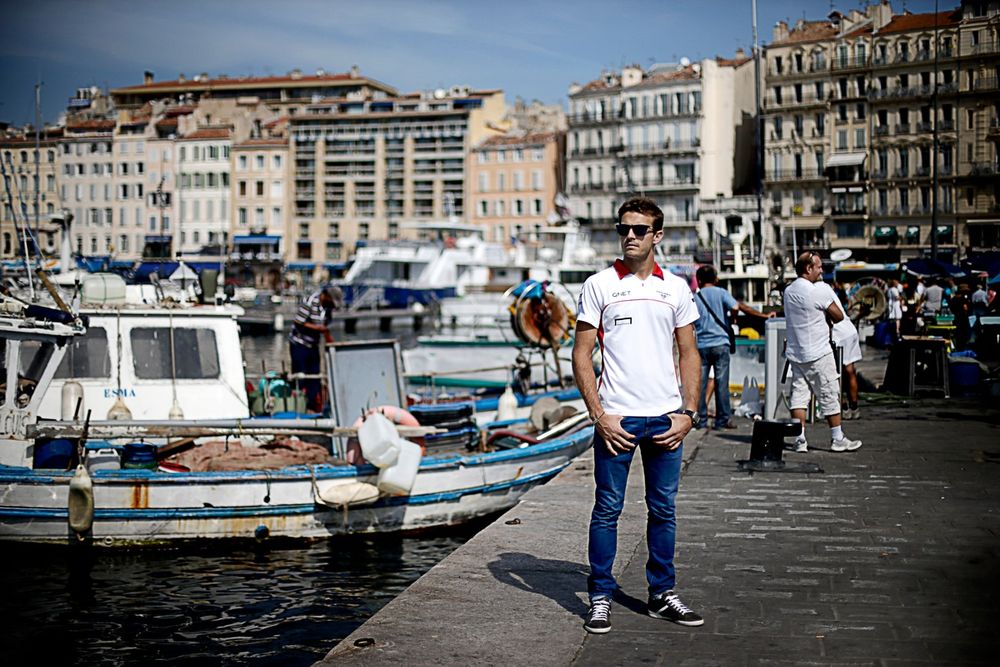
Jules Bianchi, Marussia
Photo by: Glenn Dunbar / LAT Images via Getty Images
We’re lunching in the welcome shade of the Radisson Blu hotel’s restaurant terrace, a coolly modern but discreet quayside building that doesn’t try to stand out from the older ones around it. One minute you’re skipping over the open gutter and dodging past the plastic chairs of an unconvincing ‘Irish’ pub, stealing a quick glance up a dark alleyway lit only by the garish neon sign of a tattoo parlour, then suddenly you’re in 2013 European City Of Culture Marseille, all clean glass and fresh paint.
A polite but firm wall of pot plants and chrome tubes keeps itinerants and tat-vendors at bay.
Bianchi, 24, was born in Nice but his family then moved to Gap, the alpine commune where Rui Costa won the 16th stage of this year’s centennial Tour de France, before settling in nearby Brignoles when Jules was 12. Papa Bianchi ran the local kart track.
“I like Monaco because I have friends there. And my manager [Nicolas Todt] has a house in Switzerland, so it’s convenient for me to live there. But I also like it here,” Jules explains. “I grew up in many places, but always in this area [Provence] – and it’s nice, you know? You have the sea, and the mountains aren’t far away: you have everything you need to have fun. It’s great.”
Rather like his spiritual home, Jules has a reputation for danger that he’s trying to shake off. Canvas opinion from those he’s worked with in the junior formulae, and the feedback is pretty consistent: Jules is a smart, fun, easy-going and grounded guy with no pretensions. Quick, too.
Under the wing of Nicolas Todt’s All Road Management, he won the Formula 3 Euro Series in 2009 and was signed up by the Ferrari Driver Academy. Rumour had it that he’d be a shoo-in to replace Felipe Massa at Ferrari before too long, but once in GP2 he got his elbows out rather too frequently and all too soon he’d become last year’s ‘Next Big Thing’.
“Jules is quick,” one GP2 insider told F1 Racing, “but he doesn’t look in his mirrors.”
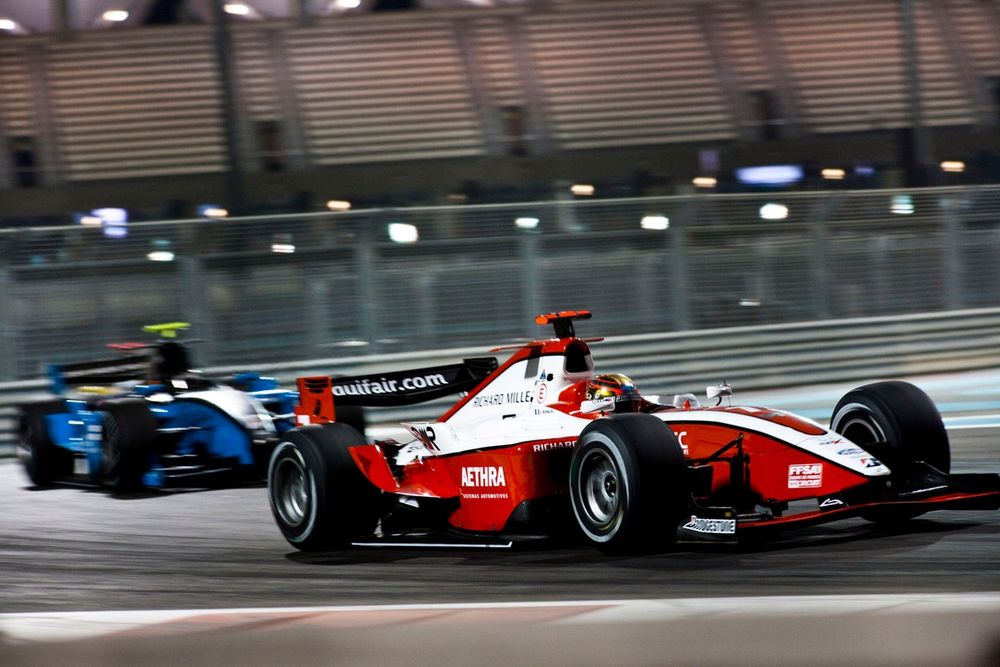
Jules Bianchi, ART Grand Prix
Photo by: GP2 Media Service
In the first of the two GP2 races supporting the 2010 Hungarian Grand Prix, Jules had an innocuous-looking accident that could have ended his career. Sweeping exuberantly around the outside at the first corner, he tapped the rear wing of Giacomo Ricci, then bravely kept his foot on the throttle while gathering the resulting twitch. His trajectory took him over the concrete run-off, where his bravura on the loud pedal was rewarded with a sharp spin back onto the track, into the face of coming traffic.
“It wasn’t that bad,” he says. “I broke one vertebra and another one was – how do you say – ‘scratched’? I had an operation in Hungary and after three weeks we went to Spa and I drove again, so I didn’t lose any opportunities to score apart from in Hungary [having crashed out of the first race, he couldn’t start the second].
“It didn’t harm my season though, because I still finished third in the championship, and it was my first year in GP2.
“It was a good season. After that,” he pauses meditatively and rearranges his salad with his fork. “Well, it doesn’t change anything really, the fact I had this crash. I haven’t had any more operations and I don’t have any ongoing problems with my back.”

Jules Bianchi, Marussia
Photo by: Glenn Dunbar / LAT Images via Getty Images
But he did have ongoing problems with his career prospects. Pastor Maldonado (also managed by Nicolas Todt) and Sergio Perez finished ahead of him in 2010 and made the leap to F1, while Jules stayed for a second season of GP2, which also resulted in third place. It wasn’t great, but it could have been worse: by Valencia, the fourth of nine race weekends, he’d managed just one podium finish and three retirements. He realised something had to change.
“Yeah, for sure I have improved,” he sighs. “There is always room for improvement. That first year in GP2, I had just won in Formula 3 the previous year and I wanted to win again. And actually it’s not as easy as that.
“I was just too focused on getting the victory. I was quick over a single lap, quick in the races all the time, but I was making mistakes and crashing. The second year, I started in the same way and it was wrong.
“I made mistakes and crashed again. At one point I was P15 in the championship. It was my second year of racing in GP2, so it was pretty bad.
“After that, I completely changed my mind and my way of driving in races. I thought much more about points and less about victory – even though I’d always want to win, of course. I did a lot of work with Ferrari on the psychological side and that was useful. It got a lot better.
“I had a good end to the season and finished third in the championship. And I had a good year in World Series [by Renault] in 2012. Maybe some people still think I’m not sure in the races, but I’ve changed. I’ve shown I can be consistent and score points. It’s not an issue anymore; I’ve grown up.”
Fortunately for Jules, the second Ferrari seat didn’t fall vacant at that point. Massa (also managed by Nicolas Todt) held on to his place – partly through merit, partly because the team didn’t want to provoke its lead driver’s ire by installing a young hotshot in the number two spot. There were talks with Mark Webber that ultimately came to nothing.
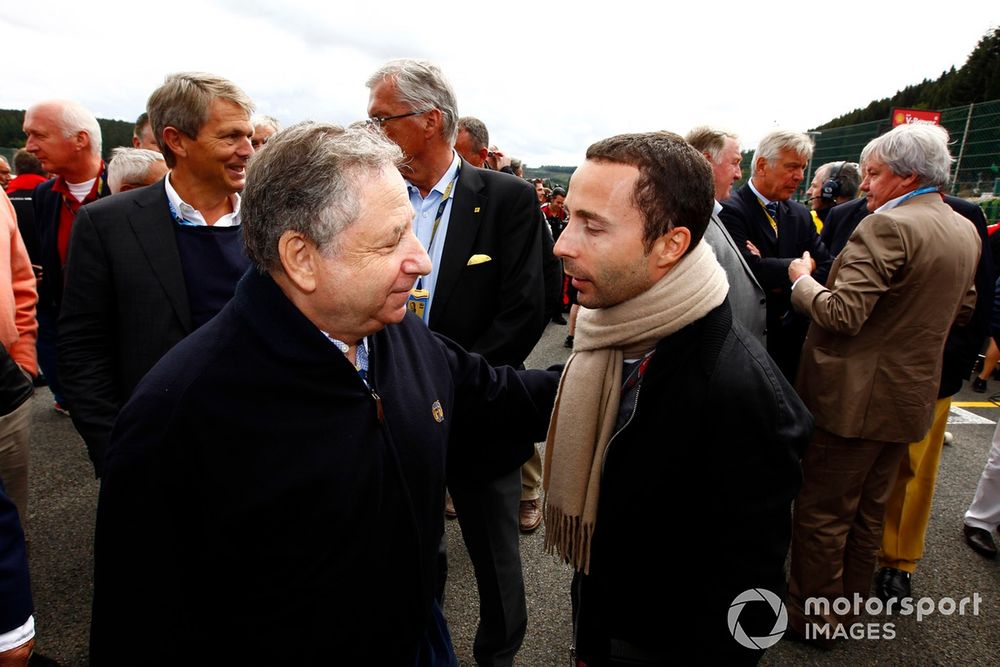
Jean Todt, President, FIA, with his son Nicolas Todt
Photo by: Charles Coates / Motorsport Images
Meanwhile, Jules rehabilitated his career throughout 2012 with a strong campaign in World Series by Renault – anyone who has to do more than two years of GP2 is pretty much a busted flush so far as F1 bigwigs are concerned, unless they come loaded with sponsorship – and nine F1 practice outings as Force India’s third driver.
Even before then he’d been quietly preparing for his F1 shot, thanks to the Ferrari Driver Academy.
“I started with Ferrari at the end of 2009, after winning my title in Formula 3, but it was 2010 when we really started to work together. I was able to do a lot of testing in the two-year-old car, and that has been really valuable because of the testing restrictions. It’s really difficult for a young driver to get the experience, to learn how to drive a Formula 1 car. Even if you’re doing GP2 or World Series, it’s not the same.
“So it was a great help for me to have this opportunity. I’ve worked a lot on the simulator, too, and done mental and physical training with them. It’s a big work together, yeah.
“I used to go a lot more. Last year, when I was the third driver for Force India, I couldn’t go to their factory and use their simulator because I was doing the Ferrari simulator. And this year I’m doing less because of my involvement with Marussia, which is the focus of most of my time. It’s important to work with the team.”
At the beginning of 2013 his career hung in the balance once more. Force India had performed a rigorous audit of Bianchi’s and Adrian Sutil’s previous form as a means of forecasting which driver would do the better job in a race seat in 2013. The team was trapped: having finished well in 2012 it needed to maintain its position in the pecking order, so as to rake in a decent share of the TV money at season’s end.
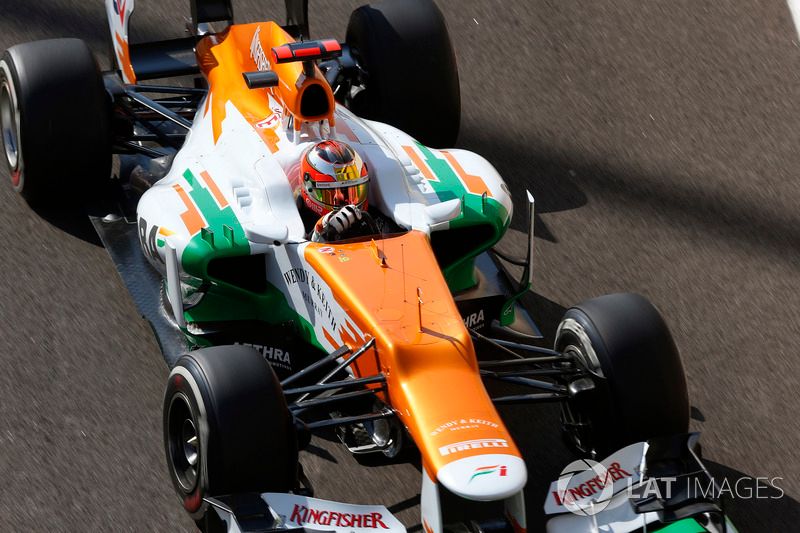
Jules Bianchi, Force India VJM05
Photo by: Charles Coates / Motorsport Images
Given the well-publicised financial pressures elsewhere in team owner Vijay Mallya’s empire, self-sufficiency was key. The rookie’s reputation for wildness went before him, and the experienced Sutil got the nod.
“We were waiting for an answer from them,” says Jules, “and it came really late – and it was the wrong answer for us! It was a difficult moment.
“I learned on the Wednesday before the final pre-season test, then on the Thursday Ferrari rang to tell me to go to Barcelona. Maybe there would be a chance with another team. But I didn’t know anything, so I didn’t have the chance to think about what I was going to do.
“Honestly, even though I’m still young, when you’ve been the third driver with one team, and then they say no to you for a race seat, and you don’t even have the opportunity to be the third driver again, it’s not really useful. I truly believe Formula 1 would have been finished for me.
“I’m really lucky to have been given this opportunity with Marussia.”
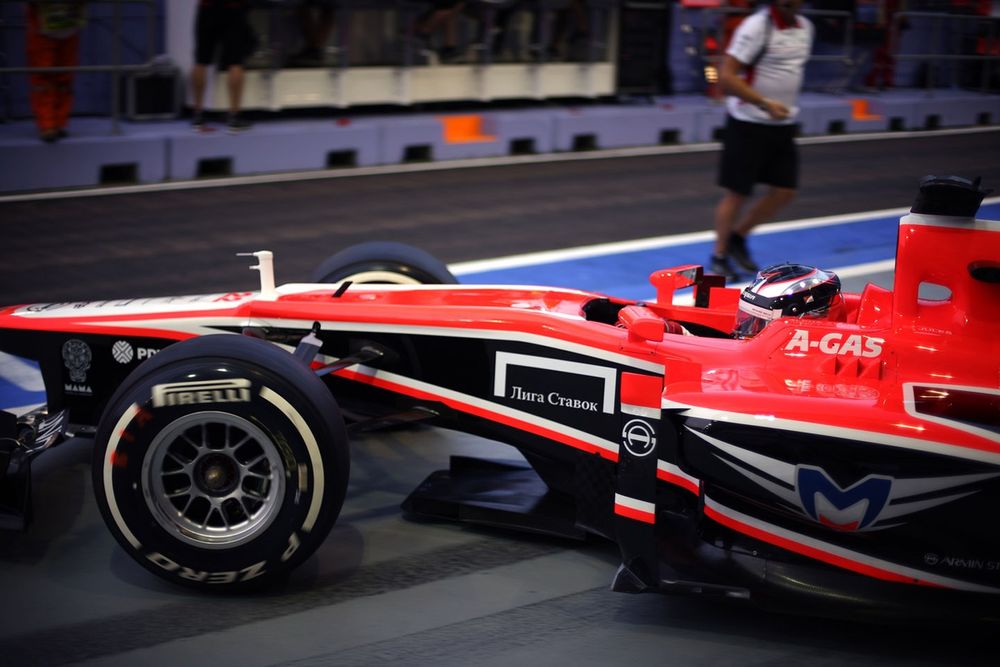
Jules Bianchi, Marussia MR02 Cosworth
Photo by: Andy Hone/ LAT Images via Getty Images
Armed with a much-improved Marussia, Jules has rammed home the point that he’s now a safe pair of hands, having retired from only two rounds (at the time of writing, post-Singapore) this year, both times through mechanical failure rather than driver brain fade. And while no one driving for this under-resourced team could expect to be challenging for podiums, there are signs that expectations are being re-mapped.
“It’s a different way to approach a race,” he says. “I know I won’t be going for a podium or maybe not even Q2 – we managed it in Spa but that’s because the conditions were special, you know? So I have different targets now. We want to beat Caterham and at the moment that’s looking like a realistic objective. It’s a victory when we’re ahead of them.
“It’s very important, not just because of the money [that comes from a higher placing in the constructors’ championship], but also to show a clear improvement, for the people at the factory who have been working so hard. We have to push to improve our performance. We need to be in Q2 more often and lead more in the race.”
Was that a coded message? Marussia has slipped back on relative pace as teams around it find greater development gains. And Jules will face an increasing level of scrutiny as the team builds its relationship with Ferrari, using a Maranello drivetrain from 2014 onwards.

Jules Bianchi, Marussia MR02 Cosworth
Photo by: Andrew Ferraro / LAT Images via Getty Images
For now, the chance to slip into Massa’s recently vacated seat may have receded, following news of Kimi Raikkonen’s return to the Scuderia. But the Finn has been signed on a one-year contract only, with an option for 2015.
“I don’t feel any pressure,” says Jules. “This is my first year in Formula 1 and I want to stay as long as possible, so I don’t want to put too much pressure on myself. I have time. I’m young. And I can improve. I want to take things step by step, I’m happy at Marussia and I want to do the best for them. I don’t see why I should leave.”
As we part company we go our separate ways on foot, neither of us hailing a taxi. Well, you’ve seen the film…
In this article
Be the first to know and subscribe for real-time news email updates on these topics

